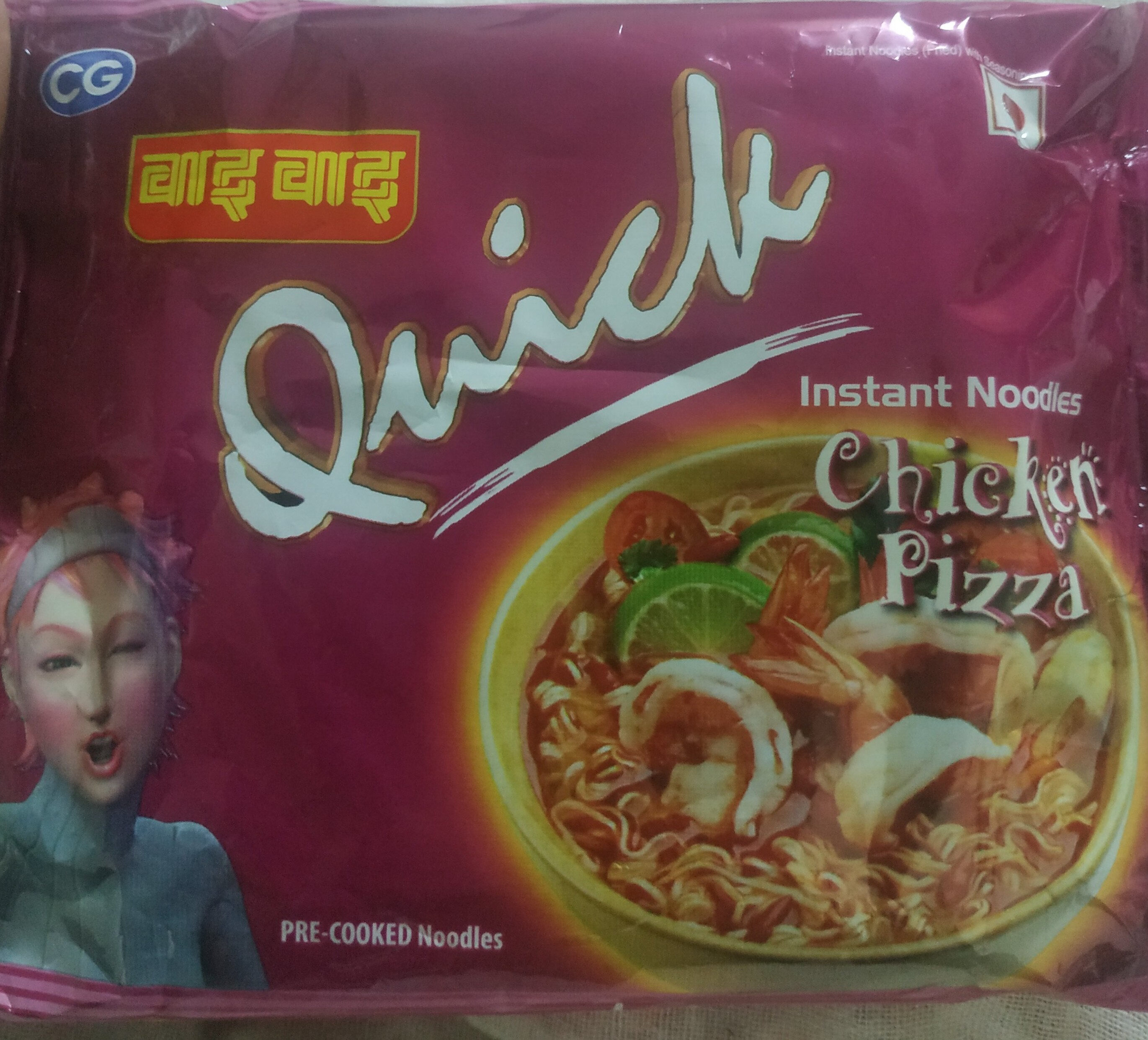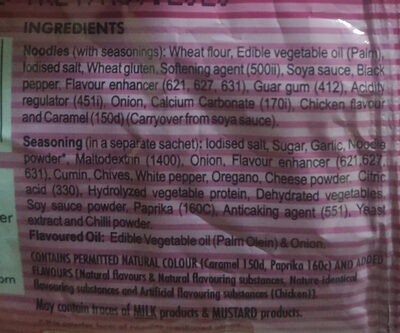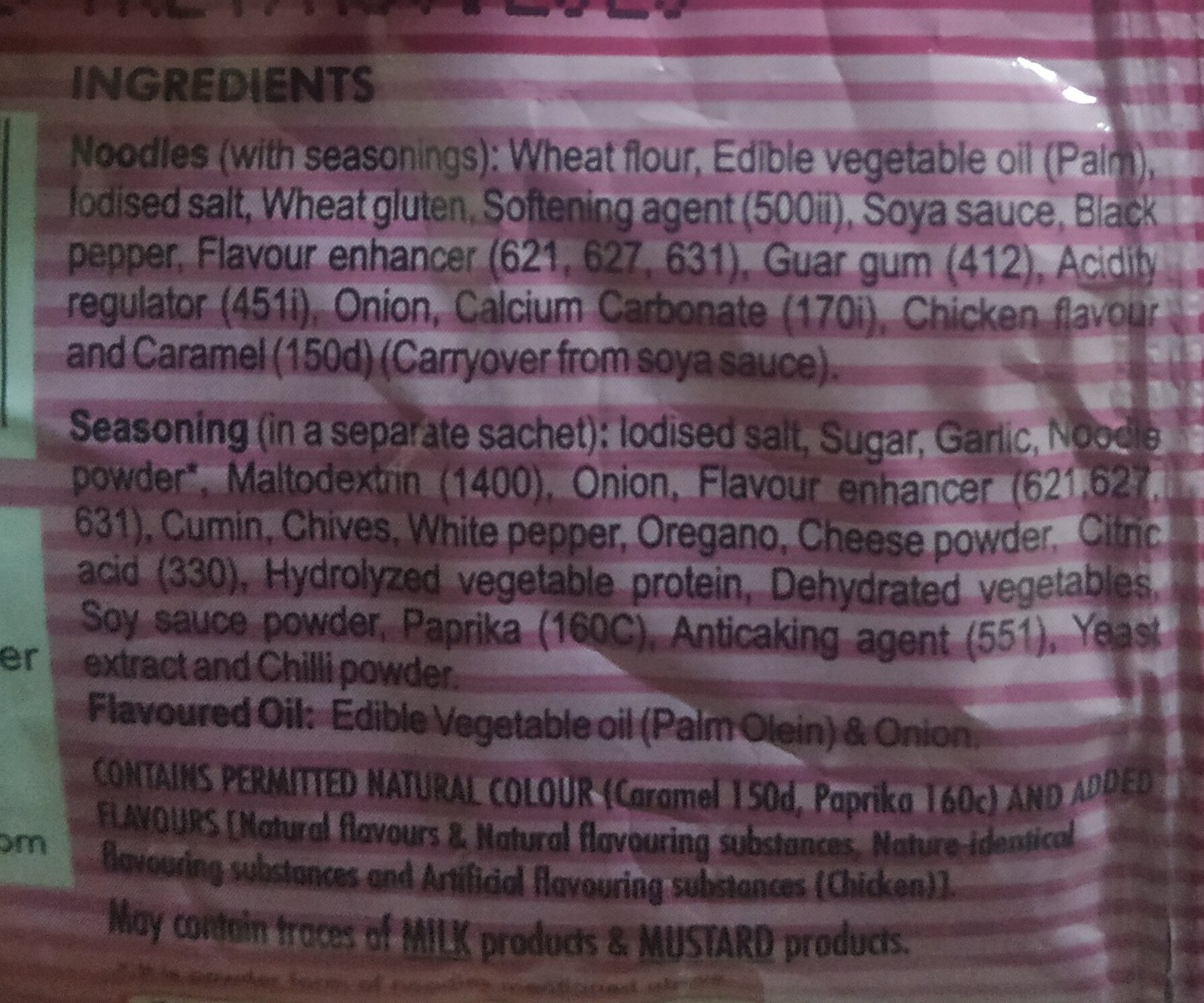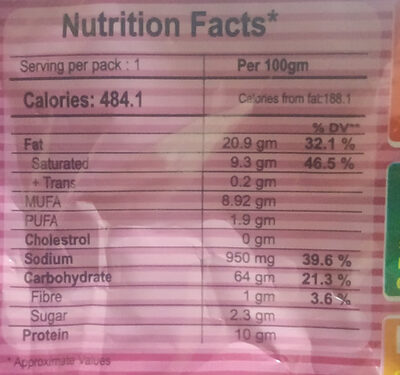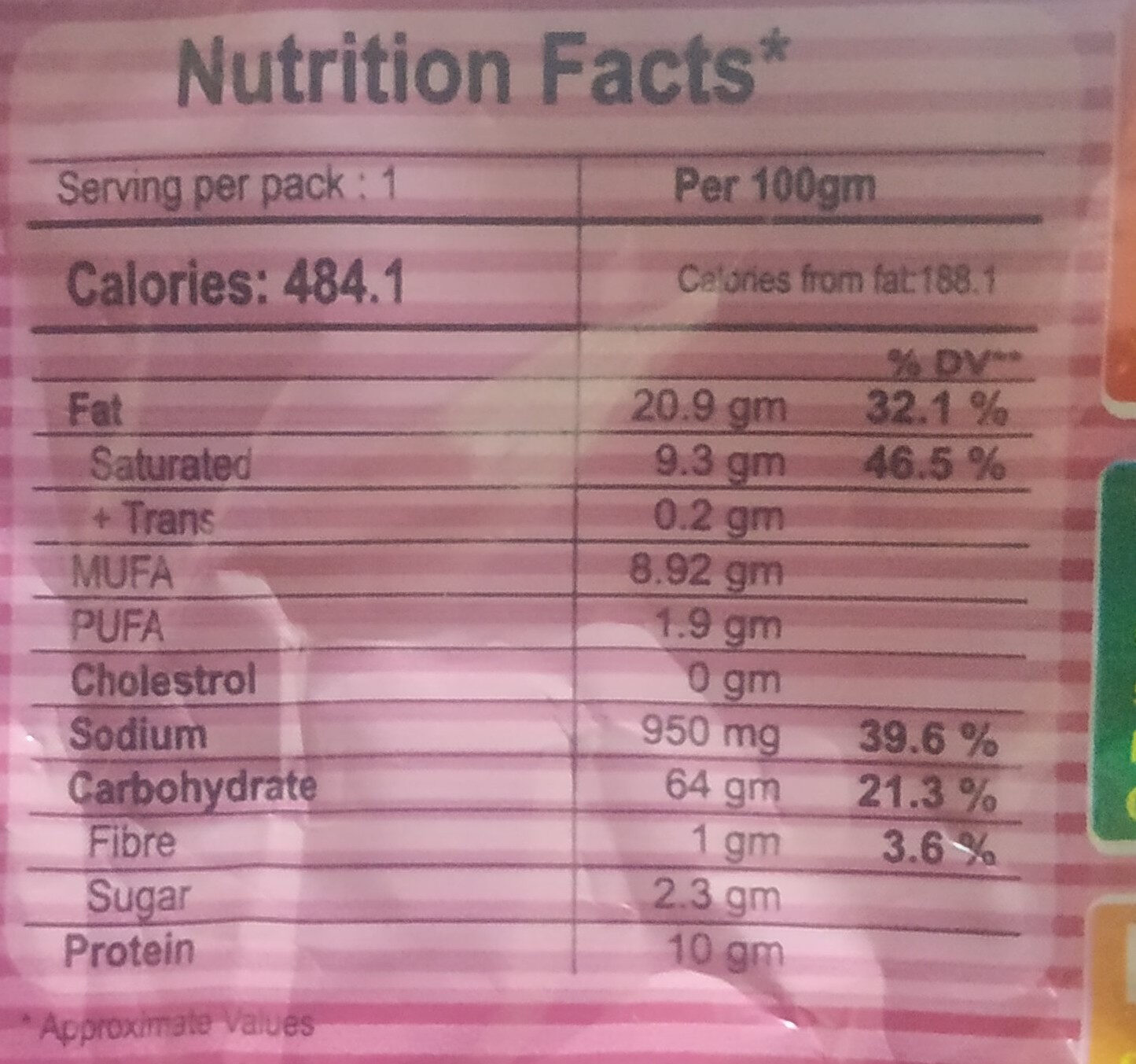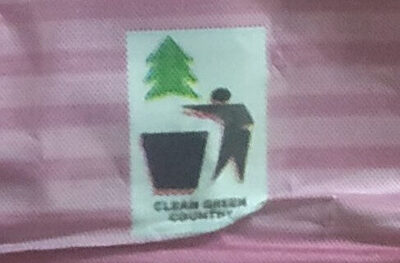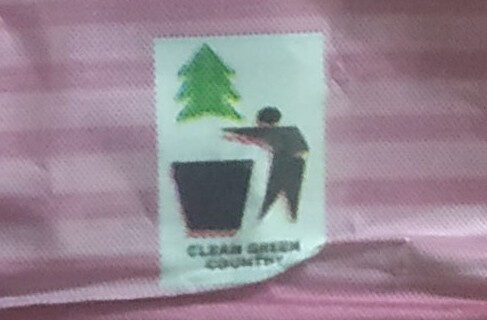Help us make food transparency the norm!
As a non-profit organization, we depend on your donations to continue informing consumers around the world about what they eat.
The food revolution starts with you!
Quick Chicken Pizza Instant Noodles - Wai Wai - 75 g
Quick Chicken Pizza Instant Noodles - Wai Wai - 75 g
This product page is not complete. You can help to complete it by editing it and adding more data from the photos we have, or by taking more photos using the app for Android or iPhone/iPad. Thank you!
×
Barcode: 8901741003027 (EAN / EAN-13)
Quantity: 75 g
Packaging: Plastic
Brands: Wai Wai
Categories: Plant-based foods and beverages, Plant-based foods, Cereals and potatoes, Cereals and their products, Dried products, Pastas, Dried products to be rehydrated, Noodles, Instant noodles
Manufacturing or processing places: Nepal
Link to the product page on the official site of the producer: https://chaudharygroup.com/index.php/our...
Stores: Big Mart
Countries where sold: Bangladesh, India, Nepal
Matching with your preferences
Health
Ingredients
-
67 ingredients
Noodles (with seasonings): Wheat flour, Edible vegetable oil (Palm), lodised salt, Wheat gluten, Softening agent (500ii), Soya sauce, Black pepper, Flavour enhancer (621, 627, 631), Guar gum (412), Acidity regulator (451i), Onion, Calcium Carbonate (170i), Chicken flavour and Caramel (150d) (Carryover from soya sauce). Seasoning (in a separate sachet): lodised salt, Sugar, Garlic, Noodle powder, Maltodextrin (1400), Onion, Flavour enhancer (621.627 631), Cumin, Chives, White pepper, Oregano, Cheese powder, Citric acid (330), Hydrolyzed vegetable protein, Dehydrated vegetables. Soy sauce powder, Paprika (160C), Anticaking agent (551). Yeast extract and Chilli powder. Flavoured Oil: Edible Vegetable oil (Palm Olein) & Onion CONTAINS PERMITTED NATURAL COLOUR (Caramel 150d, Paprika 160c) AND A FLAVOURS (Natural flavours & Natural flavouring substances, Nature identical flavouring substances and Artificial flavouring substances (Chicken). May contain traces of MILK products & MUSTARD products. This package contains added MONOSODIUM GLUTAMATE (not recommended for children under 12 months)Allergens: Chicken, GlutenTraces: Milk, Mustard
Food processing
-
Ultra processed foods
Elements that indicate the product is in the 4 - Ultra processed food and drink products group:
- Additive: E1400 - Dextrin
- Additive: E150d - Sulphite ammonia caramel
- Additive: E160c - Paprika extract
- Additive: E170 - Calcium carbonates
- Additive: E412 - Guar gum
- Additive: E451 - Triphosphates
- Additive: E551 - Silicon dioxide
- Additive: E621 - Monosodium glutamate
- Additive: E627 - Disodium guanylate
- Additive: E631 - Disodium inosinate
- Ingredient: Flavour enhancer
- Ingredient: Flavouring
- Ingredient: Gluten
- Ingredient: Maltodextrin
Food products are classified into 4 groups according to their degree of processing:
- Unprocessed or minimally processed foods
- Processed culinary ingredients
- Processed foods
- Ultra processed foods
The determination of the group is based on the category of the product and on the ingredients it contains.
Additives
-
E1400 - Dextrin
Dextrin: Dextrins are a group of low-molecular-weight carbohydrates produced by the hydrolysis of starch or glycogen. Dextrins are mixtures of polymers of D-glucose units linked by α--1→4- or α--1→6- glycosidic bonds. Dextrins can be produced from starch using enzymes like amylases, as during digestion in the human body and during malting and mashing, or by applying dry heat under acidic conditions -pyrolysis or roasting-. The latter process is used industrially, and also occurs on the surface of bread during the baking process, contributing to flavor, color and crispness. Dextrins produced by heat are also known as pyrodextrins. The starch hydrolyses during roasting under acidic conditions, and short-chained starch parts partially rebranch with α--1‚6- bonds to the degraded starch molecule. See also Maillard Reaction. Dextrins are white, yellow, or brown powders that are partially or fully water-soluble, yielding optically active solutions of low viscosity. Most of them can be detected with iodine solution, giving a red coloration; one distinguishes erythrodextrin -dextrin that colours red- and achrodextrin -giving no colour-. White and yellow dextrins from starch roasted with little or no acid are called British gum.Source: Wikipedia
-
E170 - Calcium carbonates
Calcium carbonate: Calcium carbonate is a chemical compound with the formula CaCO3. It is a common substance found in rocks as the minerals calcite and aragonite -most notably as limestone, which is a type of sedimentary rock consisting mainly of calcite- and is the main component of pearls and the shells of marine organisms, snails, and eggs. Calcium carbonate is the active ingredient in agricultural lime and is created when calcium ions in hard water react with carbonate ions to create limescale. It is medicinally used as a calcium supplement or as an antacid, but excessive consumption can be hazardous.Source: Wikipedia
-
E330 - Citric acid
Citric acid is a natural organic acid found in citrus fruits such as lemons, oranges, and limes.
It is widely used in the food industry as a flavor enhancer, acidulant, and preservative due to its tart and refreshing taste.
Citric acid is safe for consumption when used in moderation and is considered a generally recognized as safe (GRAS) food additive by regulatory agencies worldwide.
-
E412 - Guar gum
Guar gum (E412) is a natural food additive derived from guar beans.
This white, odorless powder is valued for its remarkable thickening and stabilizing properties, making it a common ingredient in various food products, including sauces, dressings, and ice creams.
When used in moderation, guar gum is considered safe for consumption, with no known adverse health effects.
-
E451 - Triphosphates
Sodium triphosphate: Sodium triphosphate -STP-, also sodium tripolyphosphate -STPP-, or tripolyphosphate -TPP-,- is an inorganic compound with formula Na5P3O10. It is the sodium salt of the polyphosphate penta-anion, which is the conjugate base of triphosphoric acid. It is produced on a large scale as a component of many domestic and industrial products, especially detergents. Environmental problems associated with eutrophication are attributed to its widespread use.Source: Wikipedia
-
E451i - Pentasodium triphosphate
Sodium triphosphate: Sodium triphosphate -STP-, also sodium tripolyphosphate -STPP-, or tripolyphosphate -TPP-,- is an inorganic compound with formula Na5P3O10. It is the sodium salt of the polyphosphate penta-anion, which is the conjugate base of triphosphoric acid. It is produced on a large scale as a component of many domestic and industrial products, especially detergents. Environmental problems associated with eutrophication are attributed to its widespread use.Source: Wikipedia
-
E551 - Silicon dioxide
Silicon dioxide: Silicon dioxide, also known as silica, silicic acid or silicic acid anydride is an oxide of silicon with the chemical formula SiO2, most commonly found in nature as quartz and in various living organisms. In many parts of the world, silica is the major constituent of sand. Silica is one of the most complex and most abundant families of materials, existing as a compound of several minerals and as synthetic product. Notable examples include fused quartz, fumed silica, silica gel, and aerogels. It is used in structural materials, microelectronics -as an electrical insulator-, and as components in the food and pharmaceutical industries. Inhaling finely divided crystalline silica is toxic and can lead to severe inflammation of the lung tissue, silicosis, bronchitis, lung cancer, and systemic autoimmune diseases, such as lupus and rheumatoid arthritis. Uptake of amorphous silicon dioxide, in high doses, leads to non-permanent short-term inflammation, where all effects heal.Source: Wikipedia
-
E621 - Monosodium glutamate
Monosodium glutamate: Monosodium glutamate -MSG, also known as sodium glutamate- is the sodium salt of glutamic acid, one of the most abundant naturally occurring non-essential amino acids. Glutamic acid is found naturally in tomatoes, grapes, cheese, mushrooms and other foods.MSG is used in the food industry as a flavor enhancer with an umami taste that intensifies the meaty, savory flavor of food, as naturally occurring glutamate does in foods such as stews and meat soups. It was first prepared in 1908 by Japanese biochemist Kikunae Ikeda, who was trying to isolate and duplicate the savory taste of kombu, an edible seaweed used as a base for many Japanese soups. MSG as a flavor enhancer balances, blends, and rounds the perception of other tastes.The U.S. Food and Drug Administration has given MSG its generally recognized as safe -GRAS- designation. A popular belief is that large doses of MSG can cause headaches and other feelings of discomfort, known as "Chinese restaurant syndrome," but double-blind tests fail to find evidence of such a reaction. The European Union classifies it as a food additive permitted in certain foods and subject to quantitative limits. MSG has the HS code 29224220 and the E number E621.Source: Wikipedia
-
E627 - Disodium guanylate
Disodium guanylate: Disodium guanylate, also known as sodium 5'-guanylate and disodium 5'-guanylate, is a natural sodium salt of the flavor enhancing nucleotide guanosine monophosphate -GMP-. Disodium guanylate is a food additive with the E number E627. It is commonly used in conjunction with glutamic acid. As it is a fairly expensive additive, it is not used independently of glutamic acid; if disodium guanylate is present in a list of ingredients but MSG does not appear to be, it is likely that glutamic acid is provided as part of another ingredient such as a processed soy protein complex. It is often added to foods in conjunction with disodium inosinate; the combination is known as disodium 5'-ribonucleotides. Disodium guanylate is produced from dried seaweed and is often added to instant noodles, potato chips and other snacks, savory rice, tinned vegetables, cured meats, and packaged soup.Source: Wikipedia
-
E631 - Disodium inosinate
Disodium inosinate: Disodium inosinate -E631- is the disodium salt of inosinic acid with the chemical formula C10H11N4Na2O8P. It is used as a food additive and often found in instant noodles, potato chips, and a variety of other snacks. Although it can be obtained from bacterial fermentation of sugars, it is often commercially prepared from animal sources.Source: Wikipedia
Ingredients analysis
-
Palm oil
Ingredients that contain palm oil: Palm oil, Palm olein
-
Non-vegan
Non-vegan ingredients: Cheese, ChickenSome ingredients could not be recognized.
We need your help!
You can help us recognize more ingredients and better analyze the list of ingredients for this product and others:
- Edit this product page to correct spelling mistakes in the ingredients list, and/or to remove ingredients in other languages and sentences that are not related to the ingredients.
- Add new entries, synonyms or translations to our multilingual lists of ingredients, ingredient processing methods, and labels.
If you would like to help, join the #ingredients channel on our Slack discussion space and/or learn about ingredients analysis on our wiki. Thank you!
-
Non-vegetarian
Non-vegetarian ingredients: ChickenSome ingredients could not be recognized.
We need your help!
You can help us recognize more ingredients and better analyze the list of ingredients for this product and others:
- Edit this product page to correct spelling mistakes in the ingredients list, and/or to remove ingredients in other languages and sentences that are not related to the ingredients.
- Add new entries, synonyms or translations to our multilingual lists of ingredients, ingredient processing methods, and labels.
If you would like to help, join the #ingredients channel on our Slack discussion space and/or learn about ingredients analysis on our wiki. Thank you!
-
Details of the analysis of the ingredients
We need your help!
Some ingredients could not be recognized.
We need your help!
You can help us recognize more ingredients and better analyze the list of ingredients for this product and others:
- Edit this product page to correct spelling mistakes in the ingredients list, and/or to remove ingredients in other languages and sentences that are not related to the ingredients.
- Add new entries, synonyms or translations to our multilingual lists of ingredients, ingredient processing methods, and labels.
If you would like to help, join the #ingredients channel on our Slack discussion space and/or learn about ingredients analysis on our wiki. Thank you!
: Noodles (with seasonings, Wheat flour), Edible Palm vegetable oil, lodised salt, Wheat gluten, Softening agent (500ii), Soya sauce, Black pepper, Flavour enhancer (621, 627, 631), Guar gum (412), Acidity regulator (451i), Onion, Calcium Carbonate (170i), Chicken flavour, Caramel (150d, Carryover from soya sauce), Seasoning (in a separate sachet, lodised salt), Sugar, Garlic, Noodle, Maltodextrin (1400), Onion, Flavour enhancer (621.627 631), Cumin, Chives, White pepper, Oregano, Cheese, Citric acid (330), Hydrolyzed vegetable protein, vegetables, Soy sauce, Paprika (160C), Anticaking agent (551), Yeast extract, Chilli, Oil (Edible Vegetable oil (Palm Olein)), Onion CONTAINS PERMITTED NATURAL COLOUR (Caramel 150d, Paprika 160c), A FLAVOURS, Natural flavours, Natural flavouring substances, Nature identical flavouring substances, Artificial flavouring substances (Chicken), products and MUSTARD products, This package contains added MONOSODIUM GLUTAMATE (not recommended for children under 12 months)- Noodles -> en:noodle - vegan: maybe - vegetarian: maybe - percent_min: 2.32558139534884 - percent_max: 100
- with seasonings -> en:coating - vegan: maybe - vegetarian: maybe - percent_min: 1.16279069767442 - percent_max: 100
- Wheat flour -> en:wheat-flour - vegan: yes - vegetarian: yes - ciqual_proxy_food_code: 9410 - percent_min: 0 - percent_max: 50
- Edible Palm vegetable oil -> en:palm-oil - vegan: yes - vegetarian: yes - from_palm_oil: yes - ciqual_food_code: 16129 - percent_min: 0 - percent_max: 50
- lodised salt -> en:lodised-salt - percent_min: 0 - percent_max: 33.3333333333333
- Wheat gluten -> en:wheat-gluten - vegan: yes - vegetarian: yes - percent_min: 0 - percent_max: 25
- Softening agent -> en:softening-agent - percent_min: 0 - percent_max: 20
- 500ii -> en:500ii - percent_min: 0 - percent_max: 20
- Soya sauce -> en:soy-sauce - vegan: maybe - vegetarian: maybe - ciqual_food_code: 11104 - percent_min: 0 - percent_max: 16.6666666666667
- Black pepper -> en:black-pepper - vegan: yes - vegetarian: yes - ciqual_food_code: 11015 - percent_min: 0 - percent_max: 14.2857142857143
- Flavour enhancer -> en:flavour-enhancer - percent_min: 0 - percent_max: 12.5
- 621 -> en:621 - percent_min: 0 - percent_max: 12.5
- 627 -> en:627 - percent_min: 0 - percent_max: 6.25
- 631 -> en:631 - percent_min: 0 - percent_max: 4.16666666666667
- Guar gum -> en:e412 - vegan: yes - vegetarian: yes - percent_min: 0 - percent_max: 11.1111111111111
- 412 -> en:412 - percent_min: 0 - percent_max: 11.1111111111111
- Acidity regulator -> en:acidity-regulator - percent_min: 0 - percent_max: 10
- 451i -> en:451i - percent_min: 0 - percent_max: 10
- Onion -> en:onion - vegan: yes - vegetarian: yes - ciqual_food_code: 20034 - percent_min: 0 - percent_max: 9.09090909090909
- Calcium Carbonate -> en:e170i - vegan: maybe - vegetarian: maybe - percent_min: 0 - percent_max: 8.33333333333333
- 170i -> en:170i - percent_min: 0 - percent_max: 8.33333333333333
- Chicken flavour -> en:chicken-flavouring - vegan: maybe - vegetarian: maybe - percent_min: 0 - percent_max: 5
- Caramel -> en:e150 - vegan: yes - vegetarian: yes - percent_min: 0 - percent_max: 5
- 150d -> en:150d - percent_min: 0 - percent_max: 5
- Carryover from soya sauce -> en:carryover-from-soya-sauce - percent_min: 0 - percent_max: 2.5
- Seasoning -> en:coating - vegan: maybe - vegetarian: maybe - percent_min: 0 - percent_max: 5
- in a separate sachet -> en:in-a-separate-sachet - percent_min: 0 - percent_max: 5
- lodised salt -> en:lodised-salt - percent_min: 0 - percent_max: 2.5
- Sugar -> en:sugar - vegan: yes - vegetarian: yes - ciqual_proxy_food_code: 31016 - percent_min: 0 - percent_max: 2.3
- Garlic -> en:garlic - vegan: yes - vegetarian: yes - ciqual_food_code: 11000 - percent_min: 0 - percent_max: 2.3
- Noodle -> en:noodle - vegan: maybe - vegetarian: maybe - percent_min: 0 - percent_max: 2.3
- Maltodextrin -> en:maltodextrin - vegan: yes - vegetarian: yes - percent_min: 0 - percent_max: 2.3
- 1400 -> en:1400 - percent_min: 0 - percent_max: 2.3
- Onion -> en:onion - vegan: yes - vegetarian: yes - ciqual_food_code: 20034 - percent_min: 0 - percent_max: 2.3
- Flavour enhancer -> en:flavour-enhancer - percent_min: 0 - percent_max: 2.3
- 621.627 631 -> en:621-627-631 - percent_min: 0 - percent_max: 2.3
- Cumin -> en:cumin - vegan: yes - vegetarian: yes - percent_min: 0 - percent_max: 2.3
- Chives -> en:chives - vegan: yes - vegetarian: yes - ciqual_food_code: 11003 - percent_min: 0 - percent_max: 2.3
- White pepper -> en:white-pepper - vegan: yes - vegetarian: yes - ciqual_food_code: 11019 - percent_min: 0 - percent_max: 2.3
- Oregano -> en:oregano - vegan: yes - vegetarian: yes - ciqual_proxy_food_code: 11035 - percent_min: 0 - percent_max: 2.3
- Cheese -> en:cheese - vegan: no - vegetarian: maybe - ciqual_proxy_food_code: 12999 - percent_min: 0 - percent_max: 2.3
- Citric acid -> en:e330 - vegan: yes - vegetarian: yes - percent_min: 0 - percent_max: 2.3
- 330 -> en:330 - percent_min: 0 - percent_max: 2.3
- Hydrolyzed vegetable protein -> en:hydrolysed-vegetable-protein - vegan: yes - vegetarian: yes - percent_min: 0 - percent_max: 2.3
- vegetables -> en:vegetable - vegan: yes - vegetarian: yes - percent_min: 0 - percent_max: 2.3
- Soy sauce -> en:soy-sauce - vegan: maybe - vegetarian: maybe - ciqual_food_code: 11104 - percent_min: 0 - percent_max: 2.3
- Paprika -> en:paprika - vegan: yes - vegetarian: yes - ciqual_food_code: 11049 - percent_min: 0 - percent_max: 2.3
- 160C -> en:160c - percent_min: 0 - percent_max: 2.3
- Anticaking agent -> en:anti-caking-agent - percent_min: 0 - percent_max: 2.3
- 551 -> en:551 - percent_min: 0 - percent_max: 2.3
- Yeast extract -> en:yeast-extract - vegan: yes - vegetarian: yes - percent_min: 0 - percent_max: 2.3
- Chilli -> en:chili-pepper - vegan: yes - vegetarian: yes - ciqual_food_code: 20151 - percent_min: 0 - percent_max: 2.3
- Oil -> en:oil - vegan: maybe - vegetarian: maybe - from_palm_oil: maybe - percent_min: 0 - percent_max: 2.3
- Edible Vegetable oil -> en:vegetable-oil - vegan: yes - vegetarian: yes - from_palm_oil: maybe - percent_min: 0 - percent_max: 2.3
- Palm Olein -> en:palm-olein - vegan: yes - vegetarian: yes - from_palm_oil: yes - ciqual_food_code: 16129 - percent_min: 0 - percent_max: 2.3
- Edible Vegetable oil -> en:vegetable-oil - vegan: yes - vegetarian: yes - from_palm_oil: maybe - percent_min: 0 - percent_max: 2.3
- Onion CONTAINS PERMITTED NATURAL COLOUR -> en:onion-contains-permitted-natural-colour - percent_min: 0 - percent_max: 2.3
- Caramel 150d -> en:caramel-150d - percent_min: 0 - percent_max: 2.3
- Paprika 160c -> en:paprika-160c - percent_min: 0 - percent_max: 1.15
- A FLAVOURS -> en:flavouring - vegan: maybe - vegetarian: maybe - percent_min: 0 - percent_max: 2.3
- Natural flavours -> en:natural-flavouring - vegan: maybe - vegetarian: maybe - percent_min: 0 - percent_max: 2.3
- Natural flavouring substances -> en:natural-flavouring - vegan: maybe - vegetarian: maybe - percent_min: 0 - percent_max: 2.3
- Nature identical flavouring substances -> en:nature-identical-flavouring - vegan: maybe - vegetarian: maybe - percent_min: 0 - percent_max: 2.3
- Artificial flavouring substances -> en:artificial-flavouring - vegan: maybe - vegetarian: maybe - percent_min: 0 - percent_max: 2.3
- Chicken -> en:chicken - vegan: no - vegetarian: no - percent_min: 0 - percent_max: 2.3
- products and MUSTARD products -> en:products-and-mustard-products - percent_min: 0 - percent_max: 2.3
- This package contains added MONOSODIUM GLUTAMATE -> en:this-package-contains-added-monosodium-glutamate - percent_min: 0 - percent_max: 2.3
- not recommended for children under 12 months -> en:not-recommended-for-children-under-12-months - percent_min: 0 - percent_max: 2.3
-
Nutrition facts
Nutrition facts As sold
for 100 g / 100 mlAs sold
per serving (75g)Compared to: Instant noodles Energy 2,025 kj
(484 kcal)1,520 kj
(363 kcal)+18% Fat 20.9 g 15.7 g +38% Saturated fat 9.3 g 6.98 g +22% Trans fat 0.2 g 0.15 g +152% Carbohydrates 64 g 48 g +8% Sugars 2.3 g 1.72 g -7% Fiber 1 g 0.75 g -56% Proteins 10 g 7.5 g +19% Salt 0 g 0 g -100% Alcohol 0 % vol 0 % vol Fruits‚ vegetables‚ nuts and rapeseed‚ walnut and olive oils (estimate from ingredients list analysis) 0.049 % 0.049 %
Environment
-
Eco-Score C - Moderate environmental impact
⚠ ️The full impact of transportation to your country is currently unknown.The Eco-Score is an experimental score that summarizes the environmental impacts of food products.→ The Eco-Score was initially developped for France and it is being extended to other European countries. The Eco-Score formula is subject to change as it is regularly improved to make it more precise and better suited to each country.Life cycle analysis
-
Average impact of products of the same category: A (Score: 82/100)
Category: Asian noodles, flavoured, dehydrated
Category: Asian noodles, flavoured, dehydrated
- PEF environmental score: 0.26 (the lower the score, the lower the impact)
- including impact on climate change: 1.67 kg CO2 eq/kg of product
Stage Impact Agriculture
65.5 %Processing
20.6 %Packaging
8.7 %Transportation
3.5 %Distribution
1.8 %Consumption
0.0 %
Bonuses and maluses
-
Missing origins of ingredients information
Malus:
⚠ ️ The origins of the ingredients of this product are not indicated.
If they are indicated on the packaging, you can modify the product sheet and add them.
If you are the manufacturer of this product, you can send us the information with our free platform for producers.
-
Ingredients that threatens species
Malus: -10
Contains palm oil
Tropical forests in Asia, Africa and Latin America are destroyed to create and expand oil palm tree plantations. The deforestation contributes to climate change, and it endangers species such as the orangutan, the pigmy elephant and the Sumatran rhino.
-
Packaging with a medium impact
Malus: -10
Shape Material Recycling Impact Unknown Plastic High ⚠ ️ The information about the packaging of this product is not sufficiently precise (exact shapes and materials of all components of the packaging).⚠ ️ For a more precise calculation of the Eco-Score, you can modify the product page and add them.
If you are the manufacturer of this product, you can send us the information with our free platform for producers.
Eco-Score for this product
-
Impact for this product: C (Score: 57/100)
Product: Quick Chicken Pizza Instant Noodles - Wai Wai - 75 g
Life cycle analysis score: 82
Sum of bonuses and maluses: -20
Final score: 57/100
-
Carbon footprint
-
Equal to driving 0.9 km in a petrol car
167 g CO² per 100g of product
The carbon emission figure comes from ADEME's Agribalyse database, for the category: Asian noodles, flavoured, dehydrated (Source: ADEME Agribalyse Database)
Stage Impact Agriculture
61.0 %Processing
14.9 %Packaging
16.3 %Transportation
6.8 %Distribution
1.0 %Consumption
0.0 %
Packaging
-
Packaging with a medium impact
-
Packaging parts
(Plastic)
-
Packaging materials
Material % Packaging weight Packaging weight per 100 g of product Plastic
-
Transportation
-
Origins of ingredients
Missing origins of ingredients information
⚠ ️ The origins of the ingredients of this product are not indicated.
If they are indicated on the packaging, you can modify the product sheet and add them.
If you are the manufacturer of this product, you can send us the information with our free platform for producers.Add the origins of ingredients for this product Add the origins of ingredients for this product
Threatened species
-
Contains palm oil
Drives deforestation and threatens species such as the orangutan
Tropical forests in Asia, Africa and Latin America are destroyed to create and expand oil palm tree plantations. The deforestation contributes to climate change, and it endangers species such as the orangutan, the pigmy elephant and the Sumatran rhino.
Report a problem
-
Incomplete or incorrect information?
Category, labels, ingredients, allergens, nutritional information, photos etc.
If the information does not match the information on the packaging, please complete or correct it. Open Food Facts is a collaborative database, and every contribution is useful for all.
Data sources
Product added on by openfoodfacts-contributors
Last edit of product page on by ecoscore-impact-estimator.
Product page also edited by nillywilly, off.91903a71-9b78-4a70-a558-cd02b5fa6770, packbot.

